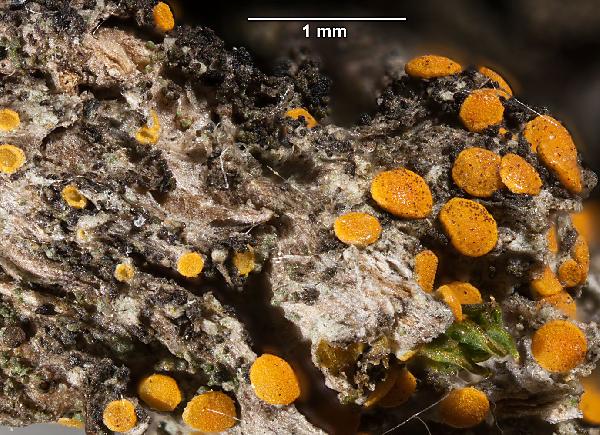Caloplaca raesaenenii Bredkina
Nov. sist. Niz. Rast., 23: 170, 1986.
Synonyms: Caloplaca geophila Räsänen nom. illegit.; Caloplaca thuringiaca Søchting & Stordeur
Distribution: N - TAA (Stordeur 2003).
Description: Thallus crustose, endosubstratic or thinly episubstratic, of very small, dispersed, greenish grey areoles that may coalesce into a more or less continuous, irregular crust. Apothecia zeorine to biatorine, at first slightly immersed, then sessile, 0.2-0.6 mm across, with an initially concave, then flat, orange disc, a thin proper margin, and a poorly developed, grey thalline margin often present only on the underside of the apothecia. Proper exciple prosoplectenchymatous; epithecium brownish orange, K+ red; hymenium colourless, 45-60 µm high; paraphyses simple or rarely slightly branched in upper part, 1-1.5 µm thick at base, the apical cells swollen, 4-5.5 µm wide; hypothecium colourless, without oil droplets. Asci 8-spored, clavate, functionally unitunicate, apically thickened with a broad internal beak, the inner part of apex and external cap I+ blue, Teloschistes-type. Ascospores 2-celled, polarilocular, hyaline, ellipsoid, 10-13 x 6-6.5 µm, the equatorial thickening (“septum”) 3-4.5 µm. Photobiont chlorococcoid. Spot tests: thallus K-, C-, KC-, P-; apothecia K+ red. Chemistry: thallus without lichen substances; apothecia with parietin (major), teloschistin, fallacinal, parietinic acid, and emodin (minor).Note: a submediterranean-Turanic to west-Pontic species described from Germany. The Italian record is from gypsum soil and plant debris (especially at the base of Artemisia annua-stems) in a rather dry area, but the species also occurs on tree bark. The taxonomic position still has to be settled (Arup in litt.; see also Vondrák & al. 2009, 2016).
Growth form: Crustose
Substrata: bark, soil, terricolous mosses, and plant debris
Photobiont: green algae other than Trentepohlia
Reproductive strategy: mainly sexual
Subcontinental: restricted to areas with a dry-subcontinental climate (e.g. dry Alpine valleys, parts of Mediterranean Italy)
Commonnes-rarity: (info)
Alpine belt: absent
Subalpine belt: absent
Oromediterranean belt: absent
Montane belt: absent
Submediterranean belt: extremely rare
Padanian area: absent
Humid submediterranean belt: absent
Humid mediterranean belt: absent
Dry mediterranean belt: absent

Predictive model
Growth form: Crustose
Substrata: bark, soil, terricolous mosses, and plant debris
Photobiont: green algae other than Trentepohlia
Reproductive strategy: mainly sexual
Subcontinental: restricted to areas with a dry-subcontinental climate (e.g. dry Alpine valleys, parts of Mediterranean Italy)
Commonnes-rarity: (info)
Alpine belt: absent
Subalpine belt: absent
Oromediterranean belt: absent
Montane belt: absent
Submediterranean belt: extremely rare
Padanian area: absent
Humid submediterranean belt: absent
Humid mediterranean belt: absent
Dry mediterranean belt: absent

Predictive model
 Index Fungorum
Index Fungorum
 GBIF
GBIF




